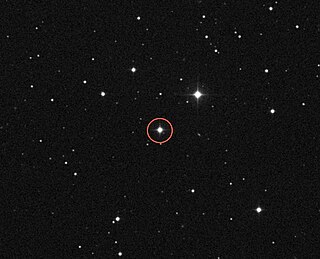Gliese 445
| Data pengamatan Epos J2000.0 Ekuinoks J2000.0 (ICRS) | |
|---|---|
| Rasi bintang | Camelopardalis |
| Asensio rekta | 11j 47m 41.3885d[1] |
| Deklinasi | +78° 41′ 28.179″[1] |
| Magnitudo tampak (V) | 10.80[2] |
| Ciri-ciri | |
| Kelas spektrum | M4.0Ve[3] |
| Indeks warna B−V | 1.572[2] |
| Astrometri | |
| Kecepatan radial (Rv) | −111.707[1] km/s |
| Gerak diri (μ) | RA: 748.111[1] mdb/thn Dek.: 480.804[1] mdb/thn |
| Paralaks (π) | 190,3251±0,0194[4] mdb |
| Jarak | 17,137 ± 0,002 tc (5,2542 ± 0,0005 pc) |
| Magnitudo mutlak (MV) | 12.227[5] |
| Detail | |
| Massa | 0.14[6] M☉ |
| Radius | 0.285[5] R☉ |
| Luminositas | 0.008[7] L☉ |
| Gravitasi permukaan (log g) | 4.72[7] |
| Suhu | 3,507[1] K |
| Metalisitas [Fe/H] | −0,30[5] |
| Kecepatan rotasi (v sin i) | <2.5[8] km/s |
| Penamaan lain | |
| Referensi basis data | |
| SIMBAD | data |
| ARICNS | data |
Location of Gliese 445 in the constellation Camelopardalis | |
Gliese 445 (Gl 445 atau AC +79 3888) adalah sebuah bintang deret utama Tipe M yang terletak pada bagian utara dari konstelasi Camelopardalis.
Lokasi
[sunting | sunting sumber]
Saat ini, bintang ini terletak pafa 17,1 tahun cahaya dari Bumi, dan memiliki magnitudo semu yaitu 10,8. Bintang ini dapat dilihat dari bagian utara dari Garis Balik Utara sepanjang malam, namun harus dengan bantuan teleskop.[10] Karena bintang ini merupakan sebuah katai merah dengan massa seperempat hingga sepertiga massa Matahari, ilmuwan mempertanyakan mengenai kemampuan Gliese 445 untuk menyandang sistem yang dapat menyokong kehidupan. Selain itu, bintang ini merupakan sumber sinar x yang diketahui.[11]
Dalam 40.000 tahun, Voyager 1 akan melewati Gliese 445 dengan jarak 1.6 dari bintang tersebut.[12]
Referensi
[sunting | sunting sumber]- ^ a b c d e f Brown, A. G. A.; et al. (kolaborasi Gaia) (Agustus 2018). "Gaia Data Release 2: Summary of the contents and survey properties". Astronomy & Astrophysics. 616. A1. arXiv:1804.09365
 . Bibcode:2018A&A...616A...1G
. Bibcode:2018A&A...616A...1G  . doi:10.1051/0004-6361/201833051
. doi:10.1051/0004-6361/201833051  . Catatan Gaia DR2 untuk sumber tersebut di VizieR.
. Catatan Gaia DR2 untuk sumber tersebut di VizieR.
- ^ a b Urban, S. E.; Zacharias, N.; Wycoff, Observatory G. L. U. S. Naval; Washington, 2004-2006 D. C. (2004). "VizieR Online Data Catalog: The UCAC2 Bright Star Supplement (Urban+, 2006)". VizieR On-line Data Catalog. Bibcode:2004yCat.1294....0U.
- ^ Lépine, Sébastien; Hilton, Eric J.; Mann, Andrew W.; Wilde, Matthew; Rojas-Ayala, Bárbara; Cruz, Kelle L.; Gaidos, Eric (2013). "A Spectroscopic Catalog of the Brightest (J < 9) M Dwarfs in the Northern Sky". The Astronomical Journal. 145 (4): 102. arXiv:1206.5991
 . Bibcode:2013AJ....145..102L. doi:10.1088/0004-6256/145/4/102.
. Bibcode:2013AJ....145..102L. doi:10.1088/0004-6256/145/4/102.
- ^ Templat:Cite Gaia EDR3
- ^ a b c Houdebine, Éric R.; Mullan, D. J.; Doyle, J. G.; de la Vieuville, Geoffroy; Butler, C. J.; Paletou, F. (2019). "The Mass-Activity Relationships in M and K Dwarfs. I. Stellar Parameters of Our Sample of M and K Dwarfs". The Astronomical Journal. 158 (2): 56. arXiv:1905.07921
 . Bibcode:2019AJ....158...56H. doi:10.3847/1538-3881/ab23fe
. Bibcode:2019AJ....158...56H. doi:10.3847/1538-3881/ab23fe  .
.
- ^ Gaidos, E.; Mann, A. W.; Lépine, S.; Buccino, A.; James, D.; Ansdell, M.; Petrucci, R.; Mauas, P.; Hilton, E. J. (2014). "Trumpeting M dwarfs with CONCH-SHELL: A catalogue of nearby cool host-stars for habitable exoplanets and life". Monthly Notices of the Royal Astronomical Society. 443 (3): 2561. arXiv:1406.7353
 . Bibcode:2014MNRAS.443.2561G. doi:10.1093/mnras/stu1313.
. Bibcode:2014MNRAS.443.2561G. doi:10.1093/mnras/stu1313.
- ^ a b McDonald, I.; Zijlstra, A. A.; Watson, R. A. (2017). "Fundamental parameters and infrared excesses of Tycho-Gaia stars". Monthly Notices of the Royal Astronomical Society. 471 (1): 770. arXiv:1706.02208
 . Bibcode:2017MNRAS.471..770M. doi:10.1093/mnras/stx1433.
. Bibcode:2017MNRAS.471..770M. doi:10.1093/mnras/stx1433.
- ^ Stelzer, B.; Marino, A.; Micela, G.; López-Santiago, J.; Liefke, C. (2013). "The UV and X-ray activity of the M dwarfs within 10 pc of the Sun". Monthly Notices of the Royal Astronomical Society. 431 (3): 2063. arXiv:1302.1061
 . Bibcode:2013MNRAS.431.2063S. doi:10.1093/mnras/stt225.
. Bibcode:2013MNRAS.431.2063S. doi:10.1093/mnras/stt225.
- ^ "GJ 445". SIMBAD. Centre de données astronomiques de Strasbourg.
- ^ Mark Littmann (1 January 2004). Planets Beyond: Discovering the Outer Solar System. Courier Corporation. ISBN 978-0-486-43602-9.
- ^ Schmitt JHMM; Fleming TA; Giampapa MS (September 1995). "The X-Ray View of the Low-Mass Stars in the Solar Neighborhood". Astrophys. J. 450 (9): 392–400. Bibcode:1995ApJ...450..392S. doi:10.1086/176149
 .
.
- ^ "NASA – Voyager - Mission - Interstellar Mission". Jet Propulsion Laboratory. Diakses tanggal 2020-04-03.


